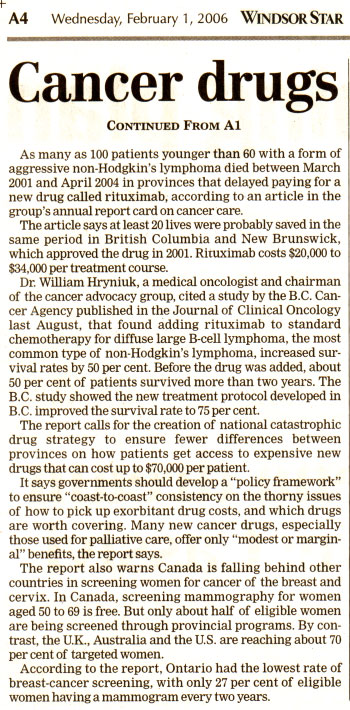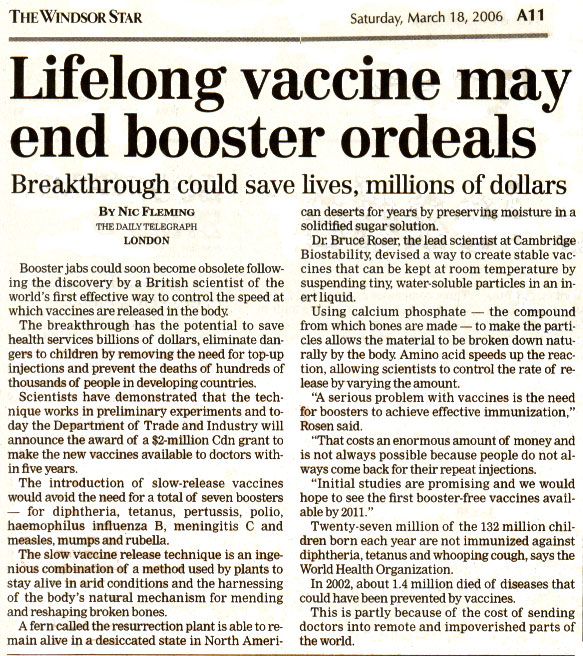
|
Cap helps reduce chemo hair loss
|
Icy head may
reduce stroke |
Migraines real pain |
|
Breakthroughs
in the Medical Field
|
Medicine 4 the soul
(Reflections on Faith)
|
|
|
April 21, 2006 BBC News
Cap helps reduce chemo hair loss
 A
new gel-filled cap has helped to reduce hair loss caused by chemotherapy in 80%
of patients, a hospital said. A
new gel-filled cap has helped to reduce hair loss caused by chemotherapy in 80%
of patients, a hospital said.
Norfolk and Norwich University Hospital said the Chemocap was designed to cool
the patient's scalp to prevent damage caused by chemotherapy drugs.
The cap is cooled and worn 15 minutes before treatment, during the process and
for up to one hour after.
Up to 48 caps are available at the hospital for patients undergoing
chemotherapy.
One of the first patients to benefit from the cap is Jane Billings, a
46-year-old mother of two from Newton Flotman, Norfolk, who underwent a
mastectomy for breast cancer in June.
Satisfied customer
She said that three weeks into her treatment she had managed to keep most of
her hair.
"As soon as I was offered chemotherapy I was concerned about losing my hair.
Then the breast nurse suggested I try the Chemocap and I was happy to give it a
go," she said.
"It's a little uncomfortable because it feels very cold, particularly round the
ears, but that's a small price to pay for keeping my hair."
Consultant oncologist, Daniel Epurescu, said: "We're delighted to be able to
offer the Chemocap to our patients as the psychological impact of losing your
hair from cancer treatment can be very distressing."
But Dr Epurescu said the cap is not suitable for all patients.
Back To Top
|
|
Friday, January 27, 2006 THE WINDSOR STAR
Icy head may reduce
stroke
 Cold
could inhibit cell death and avoid physical impairment Cold
could inhibit cell death and avoid physical impairment
BY SUSAN RUTTAN
CANWEST NEWS SERVICE
EDMONTON
When Randy Greene arrived at the emergency department last Oct. 2, paralyzed
with a stroke, he got an unusual offer - spend the next 12 hours with an
icy-cold helmet on his head.
He agreed. Today, Greene thinks the head hypothermia treatment helped him to
overcome his paralysis and make a strong recovery.
Greene, 57, was part of a study at the University of Alberta Hospital that aims
to help people survive a stroke without crippling after-effects.
"If it works," says the head of neurology for the Capital Health Region, Dr.
Ashfaq Shuaib, "it could boost the number of people who make a full recovery
from a stroke from the current 25 percent to, perhaps, 35 percent."
Shuaib is testing a combination treatment consisting of four drugs plus a
head-cooling device, to try to slow the cell death that is triggered by an
ischemic stroke. (Ischemic strokes are caused when a clot blocks blood flow to
the brain. They make up four-fifths of all strokes.)
“As you cool the brain's temperature it slows the brain's metabolic activity,”
Shuaib told reporters Thursday. “By doing that, it slows down the process that
kills these cells.”
That slowing down of brain death will give the brain time to find an alternate
blood supply through unblocked arteries, he said. It means patients may avoid
the physical and speech impairments caused when parts of the brain die.
“If it works, it's very very exciting,” Shuaib said of the study.
However, he cautioned the study is far from complete yet. To date only three
patients, including Greene, have had the full treatment and three others acted
as a control group. Shuaib plans to do 37 patients on the combined treatment,
plus 37 control patients.
Patients in the study start their therapy in the ambulance, with a paramedic
administering the first drug, magnesium sulfate. In the ER, they get the
cooling device wrapped around their heads and are given the other three
drugs.
The cooling wrap works by circulating cold water inside small tubes in the wrap.
It is normally used for migraine headaches or to help slow hair loss in
chemotherapy patients, Shuaib said.
Made by the Cincinnati Sub-Zero company, it's not been used before for strokes,
he said.
The experience of having one's head cooled to 34 C was painless but chilly, said
Greene. “The staff just kept bringing nice warm blankets every half an
hour.”
The important thing, he said, is that he went to hospital on a Sunday with his
right leg paralyzed, and by Monday evening he could wiggle his toes. He's going
back to work in March.
Shuaib said the drugs used are all familiar and relatively cheap.
What's new is the idea of putting them together in a drug cocktail, somewhat
like the AIDS drug cocktail, that will protect the brain from cell death in a
variety of ways.
The researchers hope the treatment will be effective as long as 10 hours after
the stroke occurs.
Right now, the top treatment for strokes is a clot-busting drug, but it's not
considered safe more than three hours after the stroke occurs because it may
cause brain hemorrhage.
More trials coming
The study, called MINUTES or Multiple Interventions for Neuroprotection
Utilizing Thermal Regulation in the Emergent Treatment of Stroke, has no big
drug-company funding, he said.
“The industry does not fund these trials (of drug combinations),” he said.
“They're all interested in their own drug.”
If the Edmonton trial goes well, a larger trial in other cities will be done,
Shuaib said.
Back To Top
|
|
TORONTO SUN NEWS WEDNESDAY, SEPTEMBER 21, 2005 31
Migraines real pain
3.1 million Canadian women suffer from
debilitating headaches
 SARAH
GREEN SARAH
GREEN
Toronto Sun
Don't tell Anne Fox it’s all in her head.
The 41-year-old Toronto woman said the migraine headaches she has suffered for
the past 25 years often come with crippling pain.
“They can be very debilitating,” said Fox, who
suffered 27 headaches in 35 days last March with fluctuating barometric
pressure. “My mother used to take me to the emergency room.”
A survey for Headache Network Canada released yesterday found 75% of the 3.1
million Canadian women who suffer from migraines are treated with cynicism, not
compassion.
Although Fox has supportive family and friends, she's heard others dismiss
migraines as a “headache - no big deal,” she said. “They’re not something you
make up.”
The survey found women who get migraines miss 20.8 days of work or school every
year because of them.
Fox, an account executive, recently had to leave a meeting with a client as she
felt a headache and the nausea that comes with it creeping in.
“It’s unpredictable,” said Dr. Gary Shapero, director of the Markham Headache
and Pain Treatment Centre. “They can’t really plan their lives because a
migraine can attack at anytime.”
Genetic
Women are three times more likely than men to suffer migraines. They can be
triggered by everything from bright lights and physical activity to red wine,
hormone fluctuations and changes in the weather, Shapero said. People are
genetically predisposed to migraines, he said.
The survey found 38% of those who suffer from migraines have never seen a
doctor for their pain.
Shapero urged women who get bad headaches to see their doctors and keep a diary
to help identify their triggers.
sarah.green@tor.sunpub.com
Back To Top
|
|
breakthroughs in the medical field
THE WINDSOR STAR
Wednesday, February 1, 2006
Cancer drugs
 As
many as 100 patients younger than 60 with a form of aggressive non-Hodgkin's
lymphoma died between March 2001 and April 2004 in provinces that delayed
paying for a new drug called rituximab, according to an article in the group's
annual report card on cancer care. As
many as 100 patients younger than 60 with a form of aggressive non-Hodgkin's
lymphoma died between March 2001 and April 2004 in provinces that delayed
paying for a new drug called rituximab, according to an article in the group's
annual report card on cancer care.
The article says at least 20 lives were probably saved in the same period in
British Columbia and New Brunswick, which approved the drug in 2001. Rimximab
costs $20,000 to $34,000 per treatment course.
Dr. William Hryniuk, a medical oncologist and chairman of the cancer advocacy
group, cited a study by the B.C. Cancer Agency published in the Journal of
Clinical Oncology last August, that found adding rituximab to standard
chemotherapy for diffuse large B-cell lymphoma, the most common type of
non-Hodgkin's lymphoma, increased survival rates by 50 per cent. Before the
drug was added, about 50 per cent of patients survived more than two years. The
B.C. study showed the new treatment protocol developed in B.C. improved the
survival rate to 75 per cent.
The report calls for the creation of national catastrophic drug strategy to
ensure fewer differences between provinces on how patients get access to
expensive new drugs that can cost up to $70,000 per patient.
It says governments should develop a "policy framework" to ensure
"coast-to-coast" consistency on the thorny issues of how to pick up exorbitant
drug costs, and which drugs are worth covering. Many new cancer drugs,
especially those used for palliative care, offer only "modest or marginal"
benefits, the report says.
The report also warns Canada is falling behind other countries in screening
women for cancer of the breast and cervix. In Canada, screening mammography for
women aged 50 to 69 is free. But only about half of eligible women are being
screened through provincial programs. By contrast, the U.K., Australia and the
U.S. are reaching about 70 per cent of targeted women.
According to the report, Ontario had the lowest rate of breast-cancer
screening, with only 27 per cent of eligible women having a mammogram every two
years.
THE WINDSOR STAR
Saturday, March 18, 2006
Lifelong vaccine may end booster ordeals
Breakthrough could save lives, millions of dollars
By: NIC FLEMING
THE DAILY TELEGRAPH
LONDON
 Booster
jabs could soon become obsolete following the discovery by a British scientist
of the world's first effective way to control the speed at which vaccines are
released in the body. Booster
jabs could soon become obsolete following the discovery by a British scientist
of the world's first effective way to control the speed at which vaccines are
released in the body.
The breakthrough has the potential to save health services billions of dollars,
eliminate dangers to children by removing the need for top-up injections and
prevent the deaths of hundreds of thousands of people in developing countries.
Scientists have demonstrated that the technique works in preliminary
experiments and today the Department of Trade and Industry will announce the
award of a $2-million CDN grant to make the new vaccines available to doctors
within five years.
The introduction of slow-release vaccines would avoid the need for a total of
seven boosters - for diphtheria, tetanus, pertussis, polio, haemophilus
influenza B, meningitis C and measles, mumps and rubella.
The slow vaccine release technique is an ingenious combination of a method used
by plants to stay alive in arid conditions and the harnessing of the body's
natural mechanism for mending and reshaping broken bones.
A fern called the resurrection plant is able to remain alive in a desiccated
state in North American deserts for years by preserving moisture in a
solidified sugar solution.
Dr. Bruce Roser, the lead scientist at Cambridge Biostability, devised a way to
create stable vaccines that can be kept at room temperature by suspending tiny,
water-soluble particles in an inert liquid.
Using calcium phosphate - the compound from which bones are made - to make the
particles allows the material to be broken down naturally by the body. Amino
acid speeds up the reaction, allowing scientists to control the rate of release
by varying the amount.
"A serious problem with vaccines is the need for boosters to achieve effective
immunization," Rosen said.
That costs an enormous amount of money and is not always possible because
people do not always come back for their repeat injections.
"Initial studies are promising and we would hope to see the first booster-free
vaccines available by 2011."
Twenty-seven million of the 132 million children born each year are not
immunized against diphtheria, tetanus and whooping cough, says the World Health
Organization.
In 2002, about 1.4 million died of diseases that could have been prevented by
vaccines.
This is partly because of the cost of sending doctors into remote and
impoverished parts of the world.
THE WINDSOR STAR
Saturday, January 28, 2006
FDA approves inhaled insulin
Pfizer drug yet to get nod in Canada
THE ASSOCIATED PRESS
Washington
 The
first inhaled version of insulin won federal approval Friday, giving millions
of American adult diabetics an alternative to some of the regular injections
they now endure. The
first inhaled version of insulin won federal approval Friday, giving millions
of American adult diabetics an alternative to some of the regular injections
they now endure.
The U.S. Food and Drug Administration said the Pfizer Inc. insulin, to be
marketed as Exubera, is the first new way of delivering insulin since the
discovery of the hormone by Canadians Frederick Grant Banting and Charles Best
in the 1920s. Pfizer jointly developed the drug and dispenser with
Sanofi-Aventis and Nektar Therapeutics.
Use of rapid-acting inhaled insulin will not replace the need to occasionally
inject the hormone, according to the FDA. And diabetics will have to continue
pricking their fingers to test blood sugar levels.
The FDA delayed its decision by three months so it could review chemistry data
on the diabetes treatment. The European Commission approved Exubera for use in
adults Thursday.
The drug is not approved in Canada, said a spokeswoman for Pfizer Canada.
Analysts have said the inhaled insulin could eventually become a
$1-billion-a-year seller for Pfizer, which recently agreed to pay
Sanofi-Aventis $1.3 billion US to obtain full worldwide rights to the drug for
use by both type 1 and 2 adult diabetics.
"Until today; patients with diabetes who need insulin to manage their disease
had only one way to treat their condition," said Dr. Steven Galson, director of
the FDA's Center for Drug Evaluation and Research. "It is our hope that the
availability of inhaled insulin will offer patients more options to better
control their blood sugars."
Clinical trials found that Exubera managed blood sugar levels just as well as
injected insulin, but an independent FDA panel in September stressed that use
of inhaled insulin will not mean diabetics can toss out the needles, pens or
pumps used to inject the hormone.
Inhaled insulin is a welcome advance, said Dr. Nathaniel Clark, the national
vice-president for clinical affairs for the American Diabetes Association. But
he added that needles still will allow a patient to better control dosage.
Back To Top
Wednesday, February 1, 2006
Lakeshore News -
www.windsoressexnews.com
Medicine 4 The SOUL (Reflections
on Faith)
By: Roger Campbell
 In
his helpful book, “Strength of Soul,” W. Phillip Keller says one of the most
compelling invitations ever extended by God to man came when the Lord said
quietly, “Come unto Me, all ye that labor and are heavy laden, and I will give
you rest,” (Matthew 11:28). In
his helpful book, “Strength of Soul,” W. Phillip Keller says one of the most
compelling invitations ever extended by God to man came when the Lord said
quietly, “Come unto Me, all ye that labor and are heavy laden, and I will give
you rest,” (Matthew 11:28).
He then explains that we don’t have to go far to find those laboring along with
profound personal problems, carrying heavy loads which weigh them down in
despair, frustration and grief.
Our responsibility is to be alert to their needs and respond to them.
Earlier this week, I received a call from someone facing an urgent financial
need. I was glad for the opportunity to help. Let me tell you why.
An interesting part of my work is writing sermon outline books for ministers,
each containing 104 sermon outlines (two for each Sunday of the year). There
are six of these books available in bookstores in both English and Spanish. I'm
now working on the seventh which will contain a series of outlines based on-the
Book of Proverbs.
Preceding the call, I had read Proverbs 3:26-27: “Do not withhold good from
those to whom it is due, when it is in the power of your hand to do so. Do not
say to your neighbor, 'Go and come back and tomorrow I will give it,' when you
have it with you.”
This clear Biblical text reminded me of my responsibility to be a load lifter,
loosening my grip on funds that could help and allowing me to be part of a
miracle; actually two of them: later in the day a man placed a check in my hand
amounting to nearly the amount I had given earlier.
September 18, 1957, found us serving our first church. We had three children
and were awaiting the birth of another but had no health insurance and didn't
know how we would pay the hospital expenses for the birth of this fourth child.
On that very day, a letter arrived from people in another community, who knew
nothing about the soon arrival of another child, saying they had sold their
farm and that God had let them know we had a special need.
These caring ones had thoughtfully enclosed a generous check.
The baby was born that night and the check sent was within five dollars of the
amount of the hospital bill; making them our heaven sent load lifters.
Yesterday, when concluding a telephone conversation with a customer service
representative of a bank, I said, “Have a wonderful day and remember God loves
you!”
“Thank you for saying that," she replied, her voice trembling.
"Are you going through a tough time?" I asked.
She was.
And within moments we were praying together.
Today, I'll mail a helpful book to her; one intended to replace loads with
love.
Tired and troubled people are everywhere. We meet them every day. Some are
standing in checkout lines or at cash registers. Others deliver mail or drive
fire trucks.
Some show their sorrows or stresses in their appearance and others are in happy
disguises, choosing to keep their problems to themselves.
We're deputized by our loving Lord to always be looking for these weary ones so
we can personally pass on His load-lifting invitation to come and find rest.
When we're at a loss for words and have no money to give, we can simply say,
"Have a wonderful day and remember God loves you!"
Roger Campbell can be reached by e-mail at
rcministry@ameritech.net
Back To Top
|
|
Prevent hair loss, inhibit stroke
paralysis, relieve migraine headaches, and sinus pain / pressure
|
|
|
|

